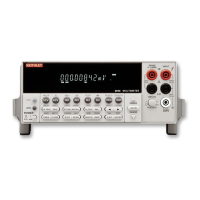Preparing the Model 2010 for calibration
1. Connect the Model 2010 to the IEEE-488 bus of the computer using a shielded
IEEE-488 cable, such as the Keithley Model 7007, or connect the unit to a computer
through the RS-232 port using a straight-through 9-pin to 9-pin cable (use a 9-25-pin
adapter if necessary).
2. Turn on the Model 2010, and allow it to warm up for two hours before performing
calibration.
3. Select the DCV function, and choose SLOW as the rate (integration time = 5PLC).
4. Make sure the primary address of the Model 2010 is the same as the address specified in
the program that you will be using to send commands. Use the GPIB key.
5. Unlock the calibration function by sending this command:
:CAL:PROT:CODE 'KI002010'
(The above command shows the default code, KI002010. Substitute the correct code if
changed.)
6. Send the following command to initiate calibration:
:CAL:PROT:INIT
Short and open calibration
1. Connect the Model 8610 low-thermal short to the instrument INPUT and SENSE
terminals as shown in Figure 2-1. Make sure the INPUTS button is not pressed in so that
the front inputs are active. Wait at least three minutes before proceeding to allow for
thermal equilibrium.
NOTE Be sure to connect the low-thermal short properly to the HI, LO, and SENSE
terminals. Keep drafts away from low-thermal connections to avoid thermal drift,
which could affect calibration accuracy.
2. Send the following command:
:CAL:PROT:DC:STEP1
3. After the Model 2010 completes this step, remove the low-thermal short and send this
command:
:CAL:PROT:DC:STEP2
2-14 Calibration

